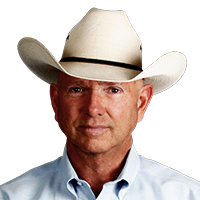Introduction to this training course… Please read this plus listen to the audio. On any page, scroll down so you don’t miss a video that is lower on the page.

Reining & cutting horse trainer, Larry Trocha
Hi – I’m Larry Trocha. The horse trainer who created this series of videos.
Thank you for purchasing this training course.
Over the years, I’ve developed a system of training methods which are effective at fixing horses with bad behavior problems. Behavior problems few trainers want to deal with or even acknowledge.
I became good at fixing these problems because I saw a real opportunity to take unwanted problem horses and turn them into useful saddle horses.
In some cases, those problem horses even went on to become big-time champions.
One of them (a bucker, kicker & striker) WON a big cutting futurity. Others have gone on to be futurity finalists on the West Coast. Some have become year-end champions in reining, cutting, reined cow horse or barrel racing.
I was unsure if I should share this knowledge!
For much of my career, I didn’t show anyone how to fix problem horse behavior.
Why? Because it’s a touchy (and often misunderstood) subject.
To successfully teach it, requires the student to understand horse nature.
So few people understand true horse nature it’s difficult to get them to realize what needs to be done to change a horse’s behavior from bad to good.
It’s even more difficult to get people to understand the KEY PRINCIPLES of having a good relationship with their horse.
Many people simply “fabricate” what they believe true horse nature is.
Because of this, they usually “fabricate” what they believe good horsemanship is too.
And of course, they fabricate it in a way to fit inline with their beliefs. It never occurs to them, their beliefs may not be accurate.
They don’t believe disciplining a horse for bad behavior is necessary. They believe they can get their horse to change his bad behavior by simply loving him, giving him treats to show their affection, etc, etc… and then they wonder why it isn’t working when their horse injures them… or puts them in the hospital.
Because of their misunderstanding of horse nature, some people will criticize a few of the training methods found in this course. Feeling it doesn’t fit their “fabricated idea” of horsemanship.
In the end, I decided to create this training course anyway. The goal being, to turn a dangerous horse into a good horse that is safer to ride. I truly felt it was my obligation.
You’ll understand WHY by listening to the audio below.
Bad consequenses for horse & rider
The starting point before moving forward with correcting bad horse behavior
#1. Make sure “pain” is not a contributing factor in your horse’s bad or dangerous behavior.
You would be amazed what pain issues are overlooked or missed by a veterinarian. Even the best equine vets can make mistakes… they are only human.
When in doubt, especially when it comes to bucking or excessive spooking, treat the horse for stomach and intestinal ulcers.
#2. Don’t discount the input of a “real” equine chiropractor. Let me stress the word “real”. There are plenty of fakes. Same goes for a “qualified” equine massage therapist. The good ones are few and far between but if you find one, it can sometimes make a big difference in your horse.
#3. Don’t discount poor “shoeing” as a factor. The good farriers who really know what they are doing are few and far between. When it comes to diagnosing a shoeing problem, I’d probably follow the farriers advice over the vet’s. Be aware, just because a farrier has won a shoeing competition does not necessarily mean he’s a good farrier in “practice”. Many of those shoeing competitions are not a true test of a farrier’s expertise.
#4. Use the services of a “professional” equine dentist. These specialists usually do a much more thorough job than a standard vet. There are many dental problems that can make a huge difference concerning pain in a horse’s mouth. I have seen buckers and spookers totally change because of a repaired fractured molar.
#5. I shouldn’t need to say this but be absolutely positive your saddle and tack aren’t causing the problems. So few people know what good saddle fit is or how to adjust the bit and curb chain. What’s just as bad… make sure “YOU” aren’t the one causing the horse’s behavior problems. Ignorance is not a good thing. Get help if needed.
#6. Whatever equine specialist you use to help you (a vet, farrier, horse trainer, etc) try to use one that actually participates in some type of equine “COMPETITION”. The person who competes on horseback almost always has more practical knowledge than the person who does not compete. Seldom have I seen an exception.
Need help? Go to Support – Contact Us and actually READ the page.
Good luck training your horse.
Larry Trocha
